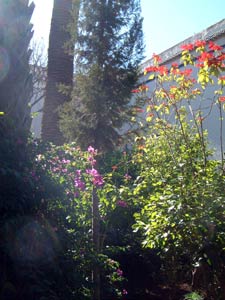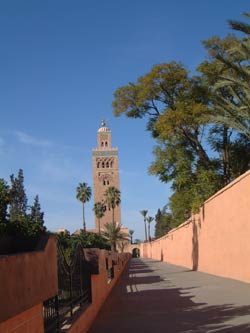|


      
|
| This
is the First stage
|
Atlas
Trekking
Marrakech |
Next:
Ouzoud
|
While Leo visited Marrakech on several occasions, his motivations for
coming at the early stages of the Sa'adian rise (before 1524 and their
capture of marrakech of course!) were those of an ambassador:
"I
was traveling then, leaving the army of the King, and going to Marrakech
to tell the ruler and the Sharif Prince that the king was on his way,
so that they could prepare for his arrival and for the upcoming battle
with the Portuguese" (Leo, 125)
Leo's Marrakech
was a rather decrepit one, a city whose earlier times of glory had faded,
and whose future times were still in the making (as the rising Sa'dian
dynasty would make it its capital). Leo looks upon this fallen city
which much empathy:
 "
[There once was ] a great beautiful garden with many types of flowers
and trees. There was a square bungalow, entirely made of marble, at
the heart of which stood a column holding a marble lion out of whose
mouth came a constant stream of clear water. At each corner of the bungalow
there was a white marble leopard. This marble is found in only one area
of the Atlas, 150 miles from Marrakech. (...) There are only a few remnants
of this city's past, but these attest to the pomp and glory of Marrakech
at the time of El Mansor. Today, all these beauties are home to crows,
owles and other birds. And this magnificent garden has become the city
dumpster!" (Leo, 106) "
[There once was ] a great beautiful garden with many types of flowers
and trees. There was a square bungalow, entirely made of marble, at
the heart of which stood a column holding a marble lion out of whose
mouth came a constant stream of clear water. At each corner of the bungalow
there was a white marble leopard. This marble is found in only one area
of the Atlas, 150 miles from Marrakech. (...) There are only a few remnants
of this city's past, but these attest to the pomp and glory of Marrakech
at the time of El Mansor. Today, all these beauties are home to crows,
owles and other birds. And this magnificent garden has become the city
dumpster!" (Leo, 106)
Only
the Koutoubia, the city's most magestic mosque still stood uncorrupted:
 "Inside
the tower [minaret] there are seven beautiful rooms, each above the
other. The ramp is perfectly lit as there are many carefully decorated
windows, which are bigger from the inside than from the outside. At
the top of the tower there is a smaller tower in the shape of a pyramid.
It has three floors which one can climb to using the wooden staircase.
At the top of this pyramid there stands a long branch which holds three
golden globes, each smaller than the one below it. All three weigh 93
Italian pounds (31 kilos). At the top of this pyramid, one can look
down, as if looking out from a ship. Below, men seem as short as little
children. You can see the mountain of Safi, 130 miles from Marrakech
[Safi is a port on the Atlantic]. "Inside
the tower [minaret] there are seven beautiful rooms, each above the
other. The ramp is perfectly lit as there are many carefully decorated
windows, which are bigger from the inside than from the outside. At
the top of the tower there is a smaller tower in the shape of a pyramid.
It has three floors which one can climb to using the wooden staircase.
At the top of this pyramid there stands a long branch which holds three
golden globes, each smaller than the one below it. All three weigh 93
Italian pounds (31 kilos). At the top of this pyramid, one can look
down, as if looking out from a ship. Below, men seem as short as little
children. You can see the mountain of Safi, 130 miles from Marrakech
[Safi is a port on the Atlantic].
Inside,
the temple is not particularly ornate. The ceiling is made of sculpted
wood, as they do in Italian churches. Truly, this is one of the most
beautiful temples in the world." (Leo, 101)
This
description of the Koutoubia as seen from inside is a real treat for all
non-muslims who are not allowed to visit mosques in Morocco.
|